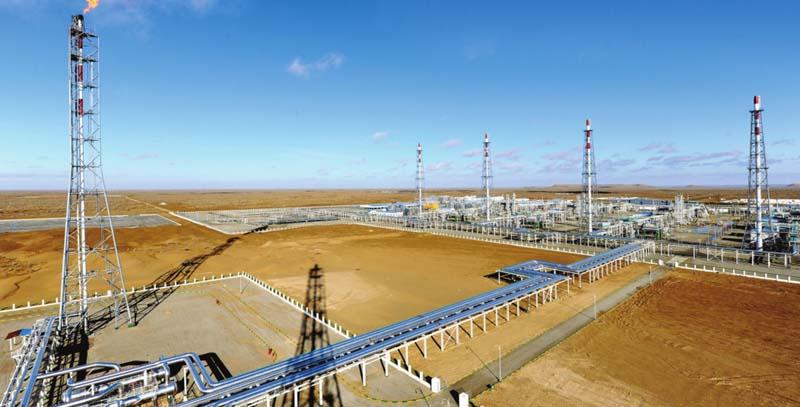WORKING TOGETHER,DEVELOPING TOGETHER
2019-04-18
Niyaz studied in China and now works as the assistant manager of the business planning department at CNPC International(Turkmenistan), the biggest gas company overseas of the energy giant China National Petroleum Corporation (CNPC), in his home country of Turkmenistan. Since he started at the company in 2008, Niyaz has grown from a layman to an expert, who has been chosen as the companys outstanding employee nine times.
“Im proud to be a CNPC employee,”he said, noting that since natural gas cooperation between China and Turkmenistan began, his countrys capital Ashkhabad has become increasingly beautiful with new buildings, roads and parks. Lebap Region, in northeast Turkmenistan, is also benefiting greatly from the cooperation; families that were previously struggling to make ends meet can now afford to buy cars.
CNPC International (Turkmenistan) is one of many CNPC overseas projects under the Silk Road Economic Belt and 21st-Century Maritime Silk Road Initiative —known as the Belt and Road Initiative—proposed by Chinese President Xi Jinping in 2013. The initiative aims to enhance connectivity along and beyond the routes of the ancient Silk Road.
Energy cooperation is an important engine of the Belt and Road Initiative. With over two decades of transnational operational experience, CNPC has become a pioneer of the initiative. In turn, the initiative offers new opportunities for more overseas oil and gas cooperation and helps the company explore new models and mechanisms in transnational operation.
Strategic cooperation
In CNPCs five strategic oil and gas cooperation zones, the ones in Central Asia, the Middle East and the Asia-Pacific region consist of Belt and Road participating countries. The equity oil and gas output in these three zones accounts for three fourths of CNPCs entire overseas equity oil and gas yield. Among the four strategic oil and gas corridors, the ones in the northwest and northeast are part of the Silk Road Economic Belt, while the China-Myanmar pipelines in the southwest are part of the 21st-Century Maritime Silk Road. In the three major oil and gas operation centers, the Asia-Pacifi c center is playing an increasingly important role in global oil and gas trade.
CNPC pursues all-win cooperation in Central Asia, where it started projects in 1997. Its operation involves exploration and development of oil and gas, pipeline construction and operation, technical services, oil refi ning and marketing, and the forming of a complete business chain. The annual oil and gas output is nearly 40 million tons. CNPC has set the goal of building Central Asia as a core oil and gas cooperation area for the Belt and Road Initiative.
With the fast development of the initiative, energy cooperation between China and Russia has made great headway. Since 2014, CNPC has accelerated its energy cooperation with Russia, which has yielded remarkable results. After the signing of a series of major agreements, such as one on the longterm supply of crude oil and another on the construction of the China-Russia east-route natural gas pipeline, the bilateral energy cooperation has accelerated.
In particular, the Yamal liquefied natural gas (LNG) project, the first extra-large overseas project for China since the Belt and Road Initiative was proposed, is being praised as a fl agship project of China-Russia cooperation.
On July 19, 2018, the first shipment of gas from the Yamal LNG project arrived in China, beginning a new chapter in the Polar Silk Road. The second and third lines of the project were put into operation in 2018, breaking world records. As the largest oil and gas cooperation project between the two countries, the Yamal LNG project has promoted the diversification of Chinas natural gas import and helped the country lower air pollutant emissions.
China and countries in the Middle East enjoyed a long history of friendly exchanges through the ancient Silk Road. As one of the most vibrant regions with huge development potential, the Middle East is the key high-end international market.
In recent years, CNPCs investment business has made major breakthroughs in the Middle East. It gained success in the construction and operation of joint oil and gas projects in Iraq, Iran and Oman, among others. The current annual output of oil and gas has exceeded 30 million tons in the region. It is also the region where CNPCs engineering technology and construction business has realized sizable “going out” in a real sense. Now there are 14 CNPC petroleum engineering technology service sub-companies in the Middle East. CNPC gives full play to its integration strategy in the region and has gained worldwide recognition.
In the Asia-Pacific region, CNPC International Indonesia has become the seventh largest petroleum company locally and has contributed to energy security in Southeast Asia. After going into operation, the China-Myanmar pipelines opened energy channels for southwest China, drove Myanmars economic and social development and benefited the people. As a main participant of benchmark crude trade in the Asia-Pacifi c region, the oil and gas operation center in Singapore has become a link between the East and the West.
Cultural exchanges
Jiang Ning, a manager at Yamal LNG in Russia, is in charge of the management of core process module construction and is the first CNPC joint venture manager stationed in the Arctic.
The LNG project cannot function without a pool of global professionals, and it is Jiangs duty to coordinate among them. “My job is to ensure that problems are properly solved so that all work progresses according to schedule,” he said.
There are no weekends while working at the site. Even walking is hard for Jiang and his colleagues because they have to dress in thick layers to keep warm outside, where temperatures can drop below minus 40 degrees Celsius. But Jiang has no complaints. For him, the ultimate goal is to enrich his experience and improve his ability by learning from working on large international projects like Yamal LNG, which combines the management concepts of world-class companies and the features of CNPC.
CNPC has also gained recognition in Central Asia. On July 12, 2018, then Prime Minister of Kazakhstan Bakhytzhan Abdiruly Sagintayev visited the Third Oil and Gas Disposal Plant of CNPC-AktobeMunaiGas. With an investment of $1.2 billion, the plant is a role model of environmental protection. It provides households in Aktobe with 1 billion cubic meters of clean natural gas annually for prices far lower than cost.
CNPC has opened a window for understanding and cultural exchanges. Mira Shunshaliyeva heads the Administration Department of CNPC International(Kazakhstan) Ltd. Her WeChat Moments are fi lled with Chinese elements such as studying the Analects of Confucius, practicing calligraphy and learning to cook Chinese dishes. She developed an interest in China and learned the Chinese language in college. As an employee of CNPC, she was sent to the China University of Petroleum for training. “I often tell my Kazakh colleagues about Chinese culture to help them better understand their Chinese counterparts,” Mira said.
CNPC International (Turkmenistan) also organizes employees from China and Turkmenistan to learn each others languages and customs. Local staff have opportunities to go to China for further studies.
“I hope that the CNPC ChinaTurkmenistan natural gas project will be the worlds best, and will be admired by all,”Niyaz said.
